Vision Analysis of the Influence of Piezoelectric Energy Harvesting on Vibration Damping of a Cantilever Beam
Abstract
:1. Introduction
2. Research Method
- The current generated by a cantilever beam containing piezoelectric material and
- displacements of several points in the cantilever beam.
2.1. Structure of Laboratory Stand
2.2. Piezoelectric Cantilever Beam
2.3. Measurement of Current Generated in Energy-Harvesting Process
2.4. Measurement of Beam Motion in Vibration-Damping Process
- analysis of the task and selection of the methods of fixing the beam and the technique of sticking the piezoelectric elements,
- selection of the hardware configuration of the vision system,
- image calibration at the laboratory station,
- recording of the sequence of images at the laboratory station,
- development of an image analysis algorithm,
- performance of measurements and archiving of measurement data.
3. Analytical Determination of Optimal Load Resistance and Shunt Resistance
3.1. Optimal Load Resitance
3.2. Optimal Shunt Resistance
3.3. Piezoelectric Material and Bimorph Properties
3.4. Power Generated in Energy-Harvesting Process
4. Results
4.1. Limiting Conditions
4.2. Energy-Harvesting Process
4.3. Vibration-Damping Process
5. Discussion
6. Conclusions
Author Contributions
Funding
Institutional Review Board Statement
Informed Consent Statement
Data Availability Statement
Conflicts of Interest
References
- Roundy, S.; Wright, P.K. A piezoelectric vibration based generator for wireless electronics. Smart Mater. Struct. 2004, 13, 1131–1142. [Google Scholar] [CrossRef] [Green Version]
- Erturk, A.; Inman, D.J. An experimentally validated bimorph cantilever model for piezoelectric energy harvesting from base excitations. Smart Mater. Struct. 2009, 18, 025009. [Google Scholar] [CrossRef]
- Yang, Y.; Tang, L.; Li, H. Vibration energy harvesting using macro-fiber composites. Smart Mater. Struct. 2009, 18, 115025. [Google Scholar] [CrossRef]
- Li, S.; Crovetto, A.; Peng, Z.; Zhang, A.; Hansen, O.; Wang, M.; Li, X.; Wang, F. Bi-resonant structure with piezoelectric PVDF films for energy harvesting from random vibration sources at low frequency. Sens. Actuators A Phys. 2016, 247, 547–554. [Google Scholar] [CrossRef] [Green Version]
- Peigney, M.; Siegert, D. Piezoelectric energy harvesting from traffic-induced bridge vibrations. Smart Mater. Struct. 2013, 22, 095019. [Google Scholar] [CrossRef] [Green Version]
- Khazaee, M.; Rezaniakolaie, A.; Moosavian, A.; Rosendahl, L. A novel method for autonomous remote condition monitoring of rotating machines using piezoelectric energy harvesting approach. Sens. Actuators A Phys. 2019, 295, 37–50. [Google Scholar] [CrossRef]
- Grzybek, D. Piezoelectric generator for the power supply of the monitoring system. In Proceedings of the 2014 15th International Carpathian Control Conference (ICCC), Velke Karlovice, Czech Republic, 28–30 May 2014; pp. 135–138. [Google Scholar]
- Liang, J.; Liao, W.-H. Energy flow in piezoelectric energy harvesting systems. Smart Mater. Struct. 2010, 20, 015005. [Google Scholar] [CrossRef]
- Lefeuvre, E.; Badel, A.; Richard, C.; Petit, L.; Guyomar, D. A comparison between several vibration-powered piezoelectric generators for standalone systems. Sens. Actuators A Phys. 2006, 126, 405–416. [Google Scholar] [CrossRef]
- Lien, I.C.; Shu, Y.-C.; Wu, W.-J.; Shiu, S.M.; Lin, H.C. Revisit of series-SSHI with comparisons to other interfacing circuits in piezoelectric energy harvesting. Smart Mater. Struct. 2010, 19, 125009. [Google Scholar] [CrossRef]
- Zhao, S.; Erturk, A. Electroelastic modeling and experimental validations of piezoelectric energy harvesting from broad-band random vibrations of cantilevered bimorphs. Smart Mater. Struct. 2012, 22, 015002. [Google Scholar] [CrossRef]
- Liao, Y.; Sodano, H.A. Modeling and Comparison of Bimorph Power Harvesters with Piezoelectric Elements Connected in Parallel and Series. J. Intell. Mater. Syst. Struct. 2009, 21, 149–159. [Google Scholar] [CrossRef]
- Billon, K.; Montcoudiol, N.; Aubry, A.; Pascual, R.; Mosca, F.; Jean, F.; Pezerat, C.; Bricault, C.; Chesné, S. Vibration isolation and damping using a piezoelectric flextensional suspension with a negative capacitance shunt. Mech. Syst. Signal Process. 2020, 140, 106696. [Google Scholar] [CrossRef]
- Gripp, J.; Rade, D. Vibration and noise control using shunted piezoelectric transducers: A review. Mech. Syst. Signal Process. 2018, 112, 359–383. [Google Scholar] [CrossRef]
- Hagood, N.W.; von Flotow, A. Damping of structural vibrations with piezoelectric materials and passive electrical net-works. J. Sound Vib. 1991, 146, 243–268. [Google Scholar] [CrossRef]
- Shevtsov, S.N.; Akopyan, V.A. Active and passive vibration control of aircraft composite structures using power piezoelectric patch-like actuators. In Piezoceramic Materials and Devices; Ivan, A., Parinov, N.-Y., Eds.; Nova Science Publishers: Hauppauge, NY, USA, 2010; pp. 285–323. [Google Scholar]
- Thomas, O.; Ducarne, J.; Deü, J.-F. Performance of piezoelectric shunts for vibration reduction. Smart Mater. Struct. 2011, 21, 015008. [Google Scholar] [CrossRef] [Green Version]
- Yun, Y.S.; Kim, J.C.; Noh, H.M.; Kim, M.S. Reduction in High-Frequency Wheel Noise/Vibration of Railway Vehicles Using Piezoelectric Shunt. Int. J. Precis. Eng. Manuf.-Green Technol. 2021, 8, 981–995. [Google Scholar] [CrossRef]
- Lossouarn, B.; Aucejo, M.; Deü, J.-F.; Multon, B. Design of inductors with high inductance values for resonant piezoelectric damping. Sens. Actuators A Phys. 2017, 259, 68–76. [Google Scholar] [CrossRef] [Green Version]
- Lesieutre, G.; Ottman, G.; Hofmann, H. Damping as a result of piezoelectric energy harvesting. J. Sound Vib. 2004, 269, 991–1001. [Google Scholar] [CrossRef]
- Liang, J.; Liao, W.-H. Piezoelectric Energy Harvesting and Dissipation on Structural Damping. J. Intell. Mater. Syst. Struct. 2008, 20, 515–527. [Google Scholar] [CrossRef]
- Shen, H.; Qiu, J.; Balsi, M. Vibration damping as a result of piezoelectric energy harvesting. Sens. Actuators A Phys. 2011, 169, 178–186. [Google Scholar] [CrossRef]
- Liao, Y.; Sodano, H.A. Optimal placement of piezoelectric material on a cantilever beam for maximum piezoelectric damping and power harvesting efficiency. Smart Mater. Struct. 2012, 21, 105014. [Google Scholar] [CrossRef]
- Grzybek, D.; Micek, P. Impact of Series and Parallel Connection of Macro Fiber Composite Patches in Piezoelectric Harvester on Energy Storage. Energies 2021, 14, 2379. [Google Scholar] [CrossRef]
- Smart Material—Home of the MFC. Available online: https://www.smart-material.com/MFC-product-mainV2.html (accessed on 5 August 2021).
- Wolszczak, P.; Łygas, K.; Litak, G. Dynamics identification of a piezoelectric vibrational energy harvester by image analysis with a high speed camera. Mech. Syst. Signal Process. 2018, 107, 43–52. [Google Scholar] [CrossRef]
- Romaszko, M.; Sapiński, B.; Sioma, A. Forced vibrations analysis of a cantilever beam using the vision method. J. Theor. Appl. Mech. 2015, 53, 243–254. [Google Scholar] [CrossRef]
- Sioma, A. Geometry and resolution in triangulation vision systems. In Photonics Applications in Astronomy, Communications, Industry, and High Energy Physics Experiments 2020; SPIE: Bellingham, WA, USA, 2020; Volume 11581, p. 115810. [Google Scholar]
- Al-Ashtari, W.; Hunstig, M.; Hemsel, T.; Sextro, W. Frequency tuning of piezoelectric energy harvesters by magnetic force. Smart Mater. Struct. 2012, 21, 035019. [Google Scholar] [CrossRef]
- Deraemaeker, A.; Nasser, H.; Benjeddou, A.; Preumont, A. Mixing Rules for the Piezoelectric Properties of Macro Fiber Composites. J. Intell. Mater. Syst. Struct. 2009, 20, 1475–1482. [Google Scholar] [CrossRef] [Green Version]
- Biscani, F.; Nasser, H.; Belouettar, S.; Carrera, E. Equivalent electro-elastic properties of Macro Fiber Composite (MFC) transducers using asymptotic expansion approach. Compos. Part B Eng. 2011, 42, 444–455. [Google Scholar] [CrossRef]
- Wilkie, W.K.; Inman, D.J.; Lloyd, J.M.; High, J.W. Anisotropic Laminar Piezocomposite Actuator Incorporating Machined PMN–PT Single-crystal Fibers. J. Intell. Mater. Syst. Struct. 2006, 17, 15–28. [Google Scholar] [CrossRef] [Green Version]
- Erturk, A.; Inman, D.J. Appendix E: Numerical Data for PZT-5A and PZT-5H Piezoceramics. Piezoelectric Energy Harvest. 2011, 373–374. [Google Scholar] [CrossRef]
- Grzybek, D.; Micek, P. Experimental investigation on the piezoelectric energy harvester as the self-powered vibration sensor. J. Theor. Appl. Mech. 2018, 56, 687–699. [Google Scholar] [CrossRef] [Green Version]
- Roundy, S.; Leland, E.S.; Baker, J.; Carleton, E.; Reilly, E.; Lai, E.; Otis, B.; Rabaey, J.M.; Wright, P.K.; Sundararajan, V. Improving power output for vibration-based energy scavengers. IEEE Pervasive Comput. 2005, 4, 28–36. [Google Scholar] [CrossRef]
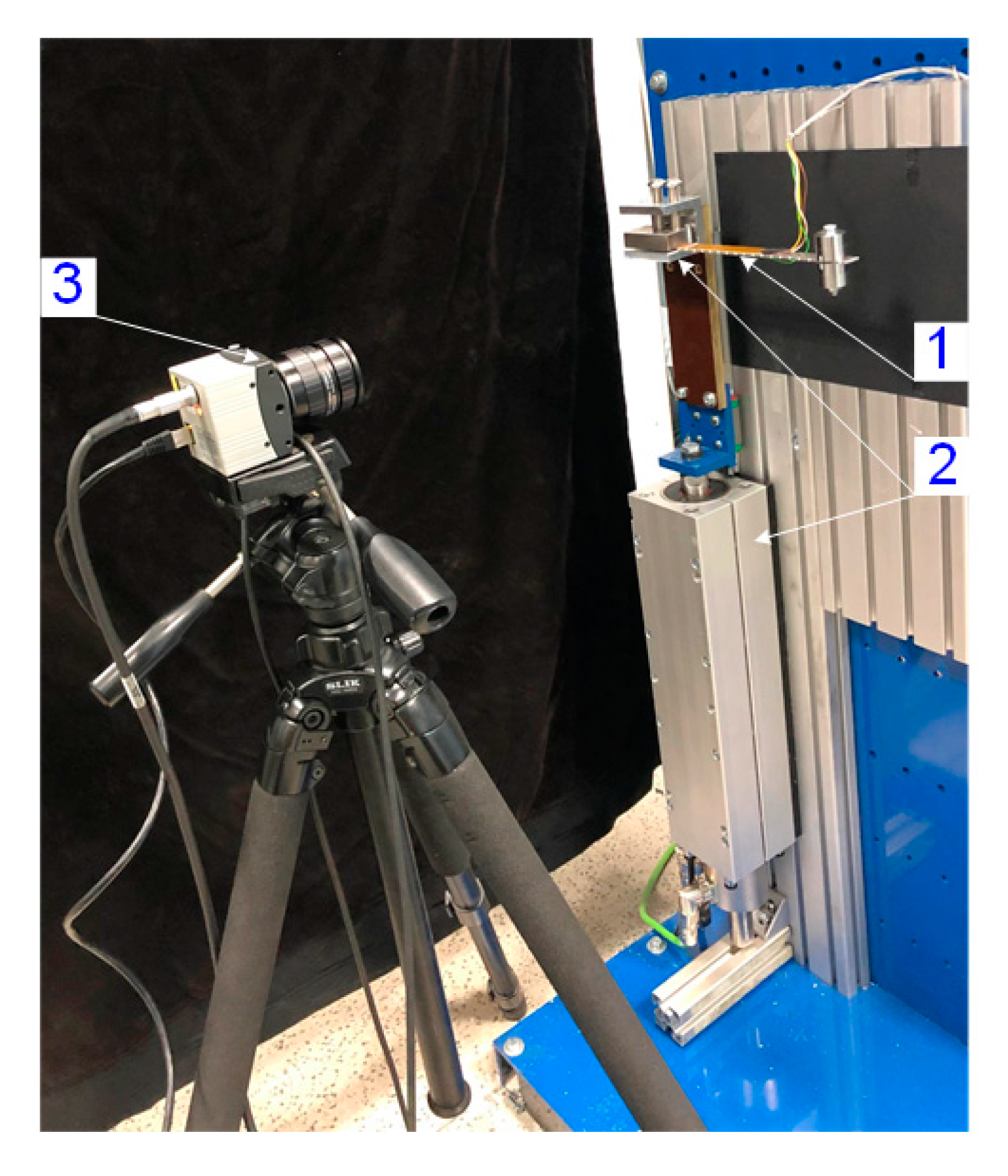

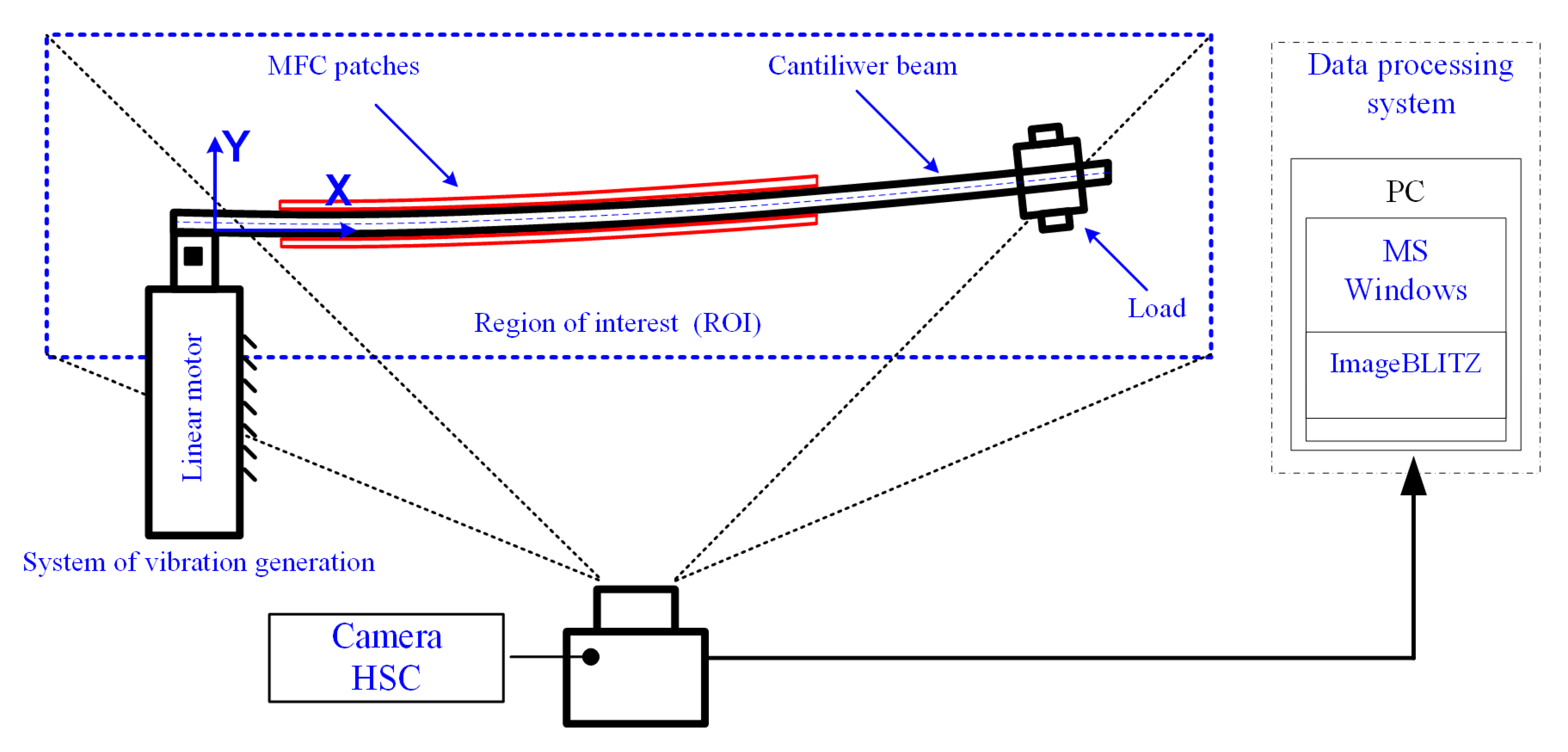
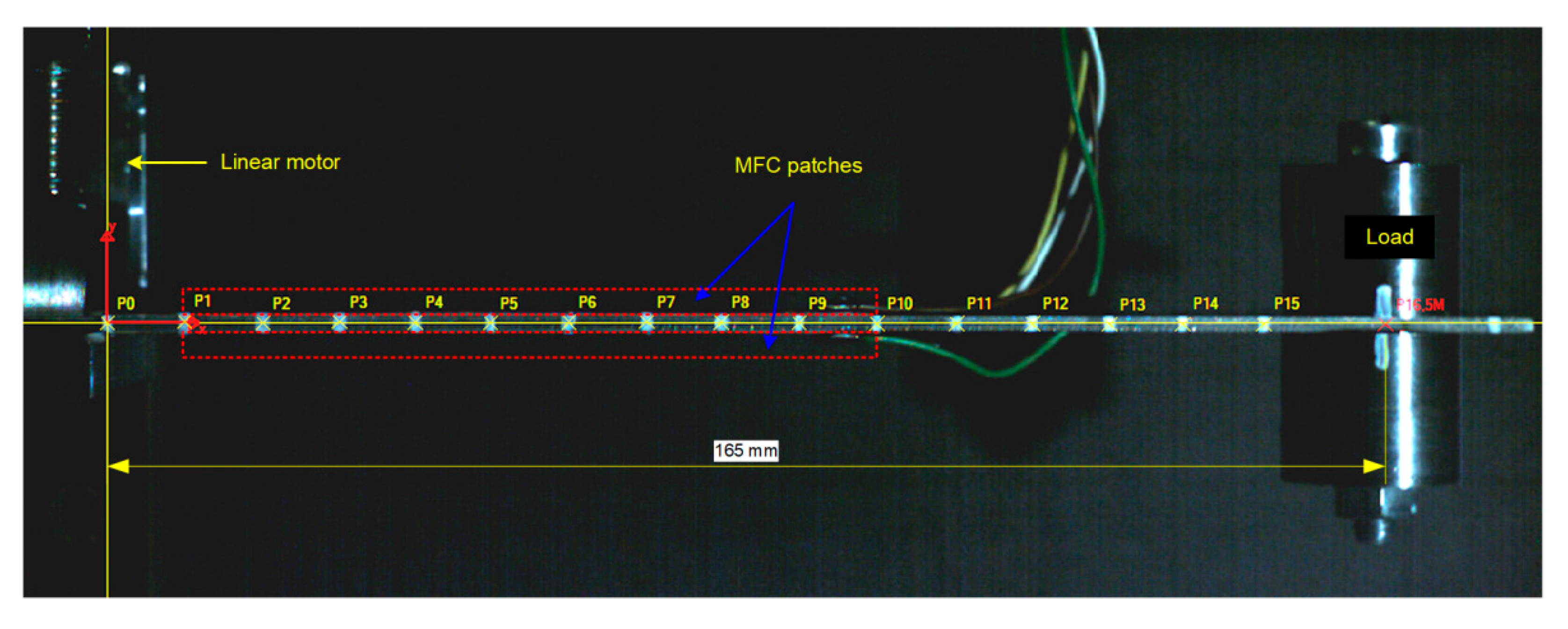
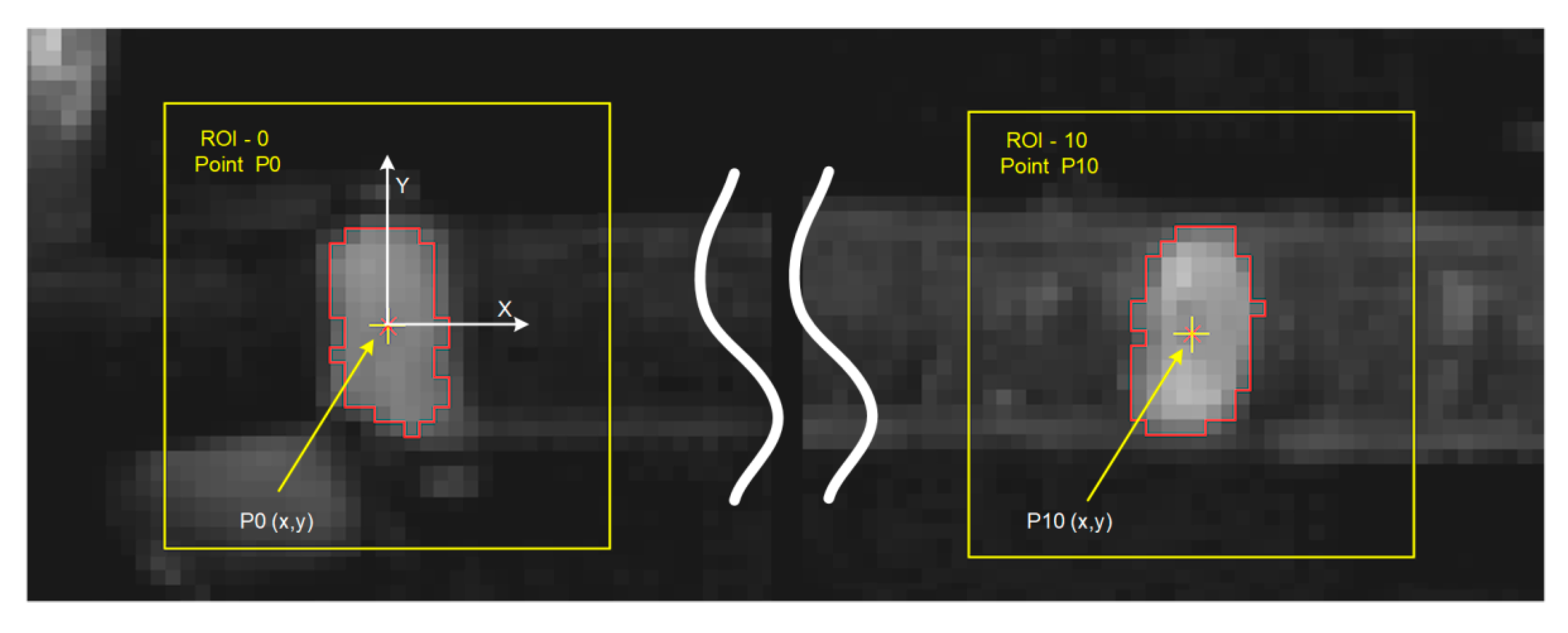
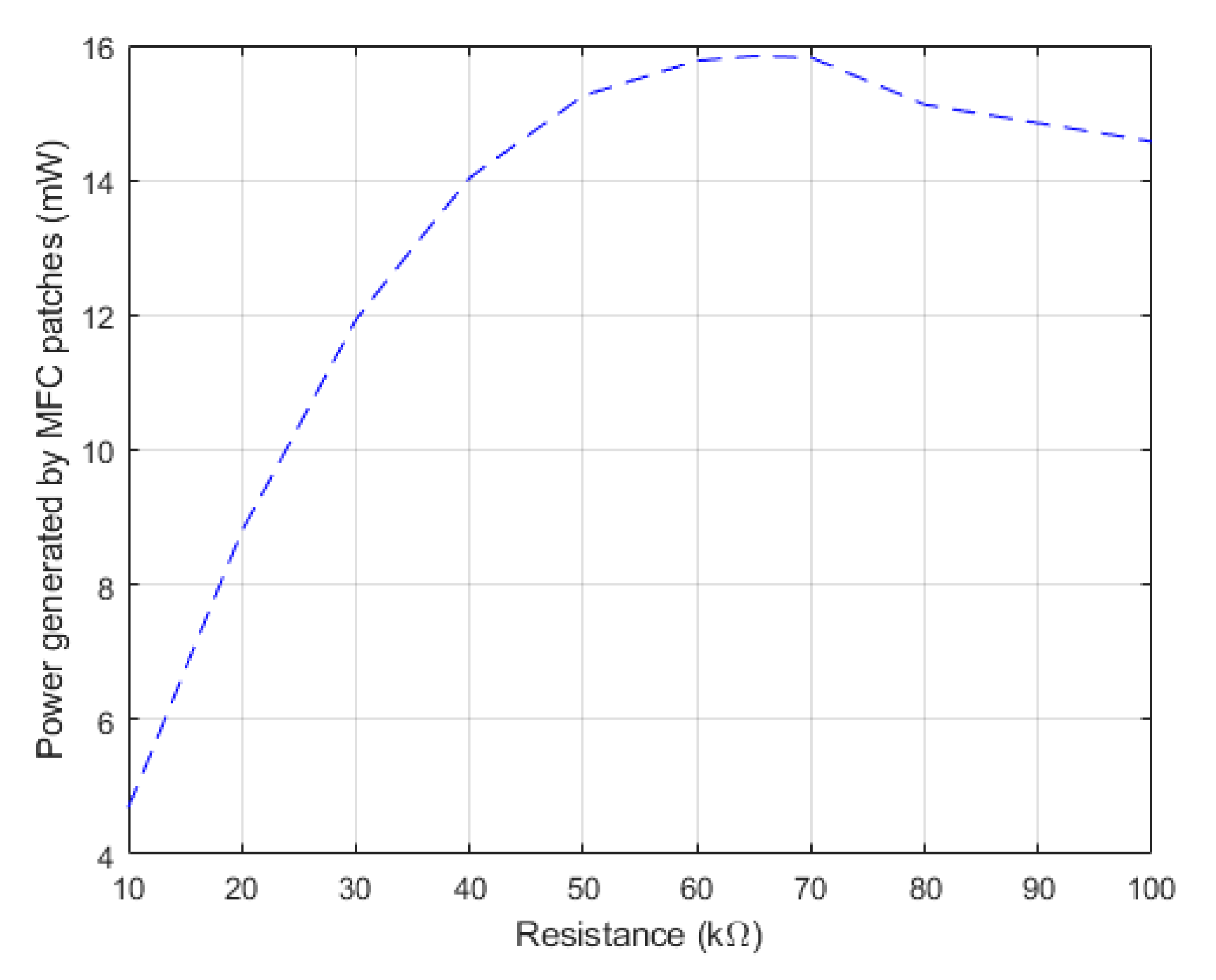



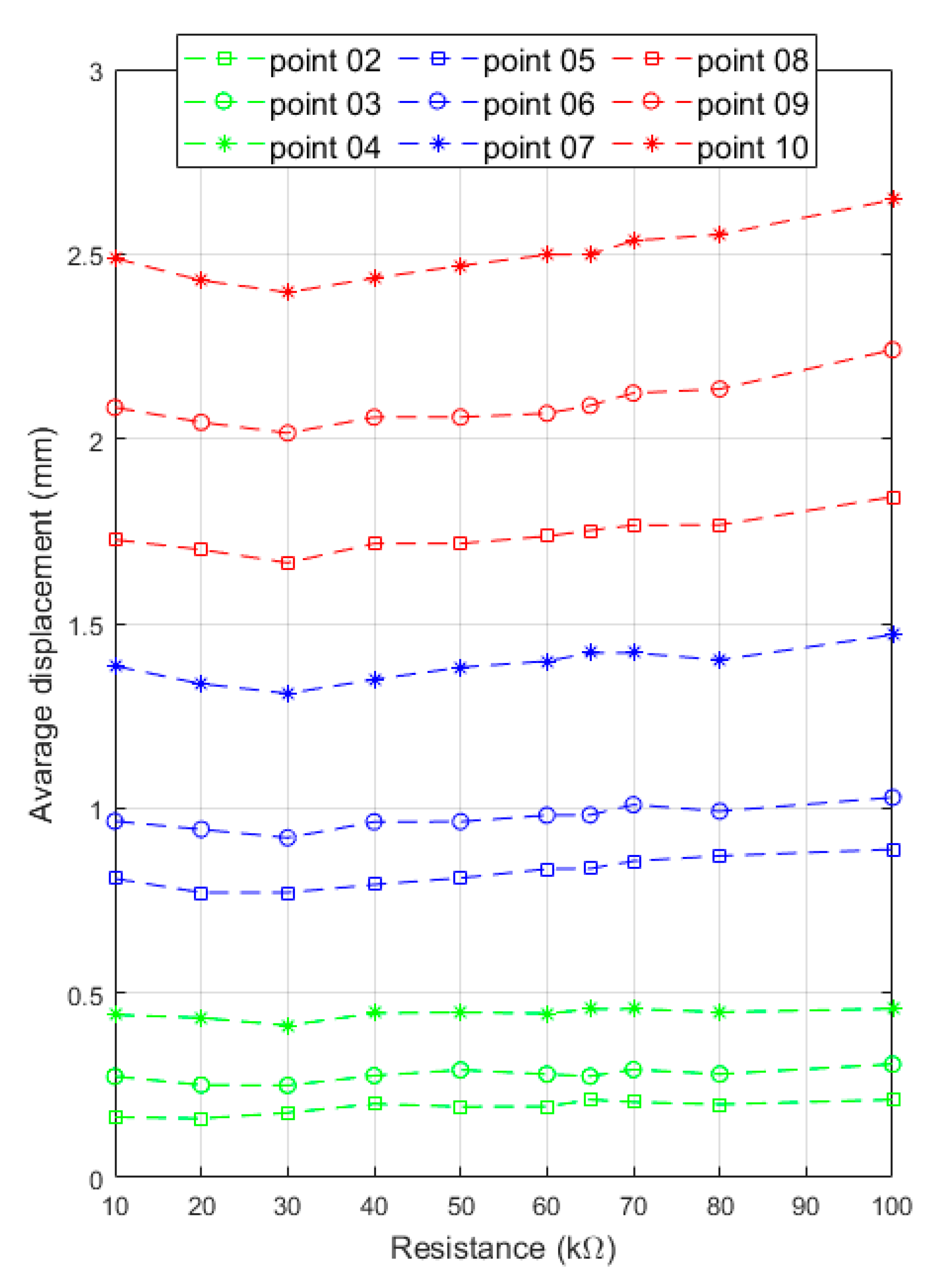
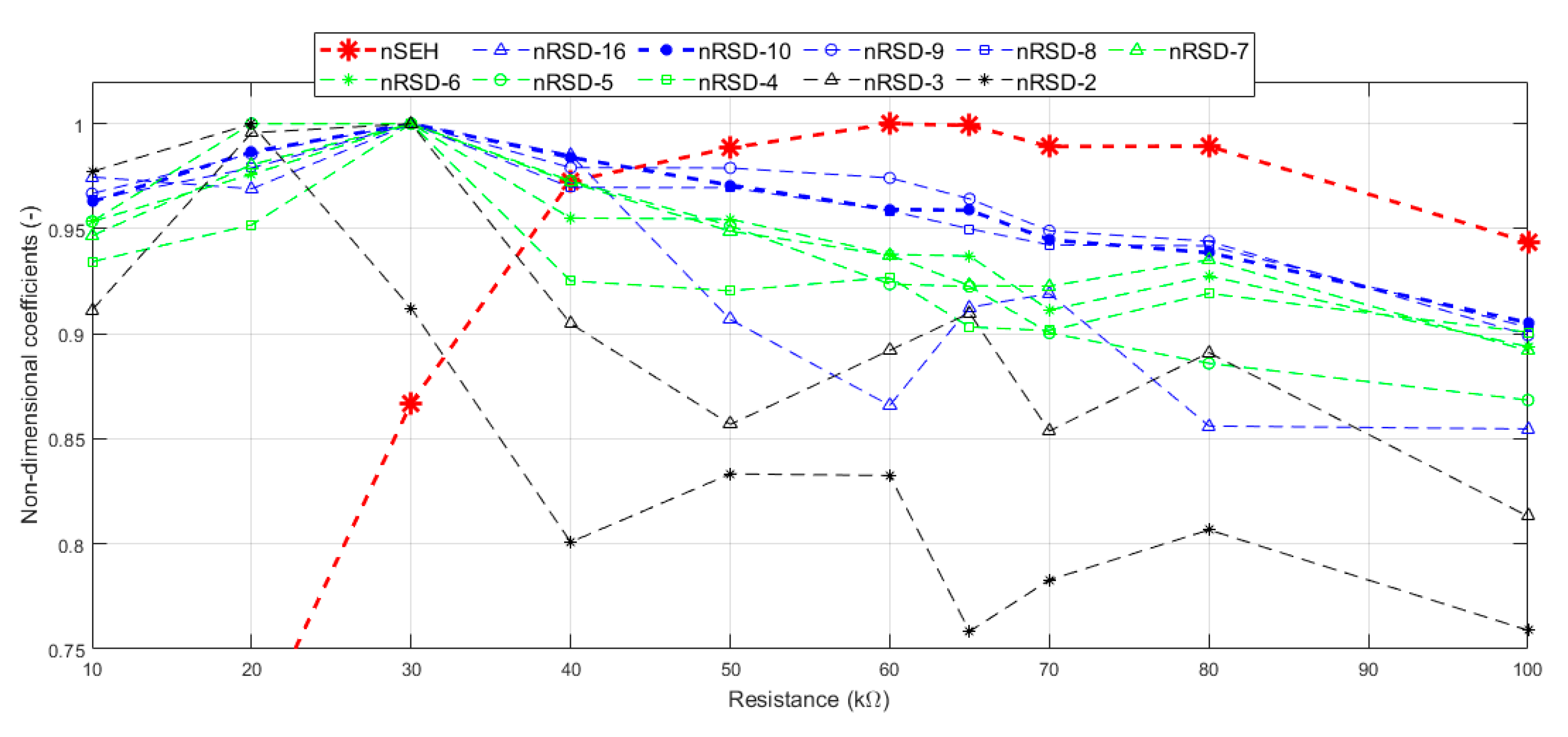
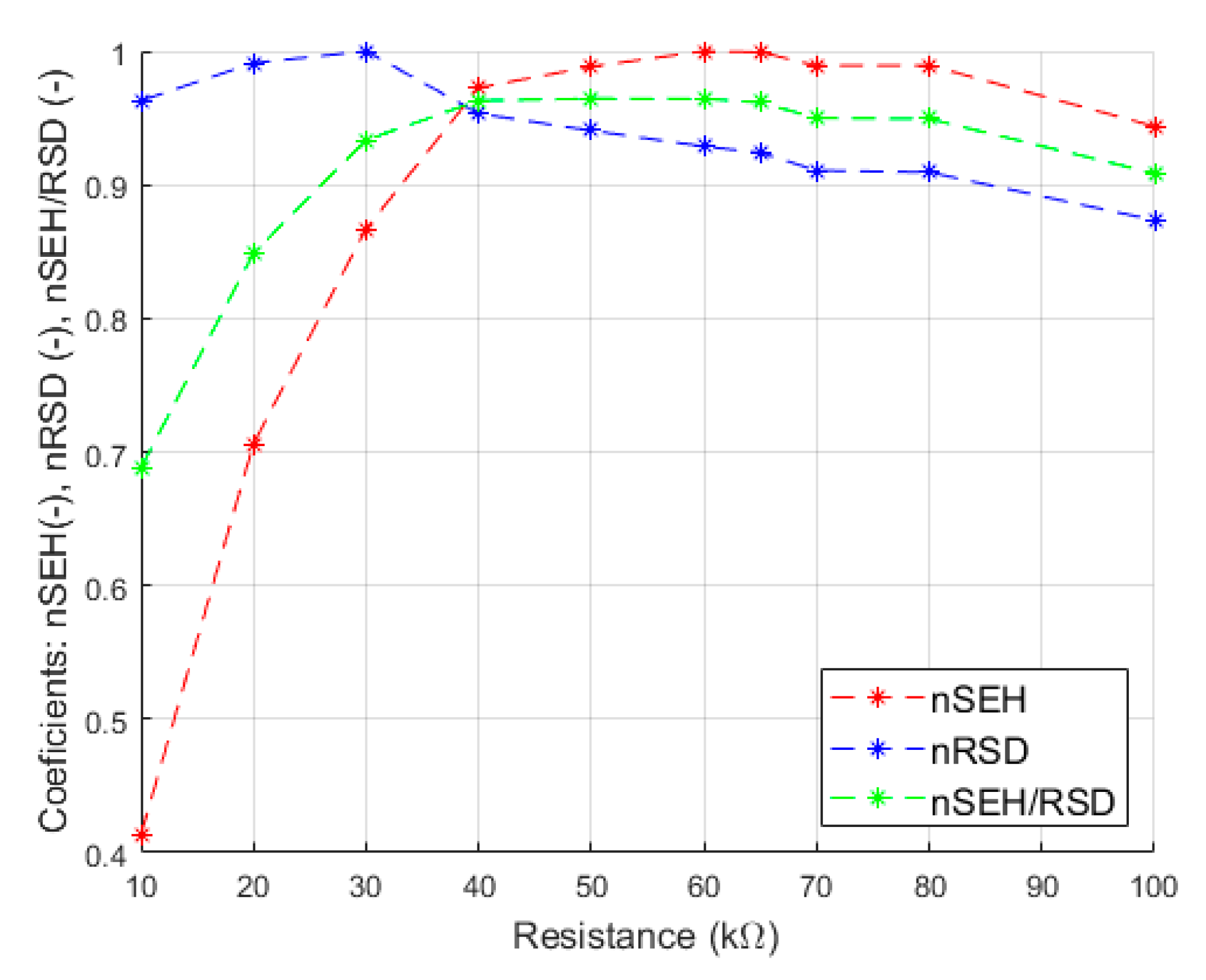
| Parameters | Symbol | Unit | Value |
|---|---|---|---|
| Length of piezoelectric fiber inside MFC patch | lp | mm | 85 |
| Length of MFC patch | lMFC | mm | 100 |
| Length of cantilever beam | lb | mm | 165 |
| Width of active area in MFC patch | wact | mm | 14 |
| Width of steel substrate | wb | mm | 16 |
| Thickness of piezoelectric fibers in MFC patch | tp | mm | 0.18 |
| Thickness of MFC patch | tMFC | mm | 0.3 |
| Thickness of steel substrate | ts | mm | 2 |
| Parameters | Symbol | Unit | Value |
|---|---|---|---|
| Compliance constant of MFC patch [30] | s11 | m2 × N−1 | 21.2 × 10−12 |
| Young’s modulus of steel substrate | Ys | Pa | 205 × 109 |
| Mass of beam | mb | kg | 0.046 |
| Additional mass | ma | kg | 0.142 |
| Material Property | Symbol | Unit | Value |
|---|---|---|---|
| Piezoelectric constant | e31 | C/m2 | 10.4 |
| Permittivity at constant strain | εS33 | F/m | 13.3 × 10−9 |
| Elastic stiffness constant | cE11 | Pa | 61 × 106 |
| Calculated Parameters | Symbol | Unit | Value |
|---|---|---|---|
| Natural frequency of cantilever beam | ωn | rad/s | 102.4496 |
| Piezoelectric capacity at constant strain | CSpMFC | F | 7.6058 × 10−8 |
| Optimal load resistance | Rlopt | kΩ | 64.168 |
| Optimal shunt resistance | RSopt | kΩ | 21.904 |
| Parameters | Symbol | Unit | Value |
|---|---|---|---|
| Frequency of fixed end of cantilever beam | ffe | Hz | 16.3 |
| Amplitude of fixed end of cantilever beam | Afe | mm | 0.2 |
| Values of resistance | Rl = s | kΩ | 10, 20, 30, 40, 50, 60, 65, 70, 80 100 |
Publisher’s Note: MDPI stays neutral with regard to jurisdictional claims in published maps and institutional affiliations. |
© 2021 by the authors. Licensee MDPI, Basel, Switzerland. This article is an open access article distributed under the terms and conditions of the Creative Commons Attribution (CC BY) license (https://creativecommons.org/licenses/by/4.0/).
Share and Cite
Grzybek, D.; Sioma, A. Vision Analysis of the Influence of Piezoelectric Energy Harvesting on Vibration Damping of a Cantilever Beam. Energies 2021, 14, 7168. https://doi.org/10.3390/en14217168
Grzybek D, Sioma A. Vision Analysis of the Influence of Piezoelectric Energy Harvesting on Vibration Damping of a Cantilever Beam. Energies. 2021; 14(21):7168. https://doi.org/10.3390/en14217168
Chicago/Turabian StyleGrzybek, Dariusz, and Andrzej Sioma. 2021. "Vision Analysis of the Influence of Piezoelectric Energy Harvesting on Vibration Damping of a Cantilever Beam" Energies 14, no. 21: 7168. https://doi.org/10.3390/en14217168






